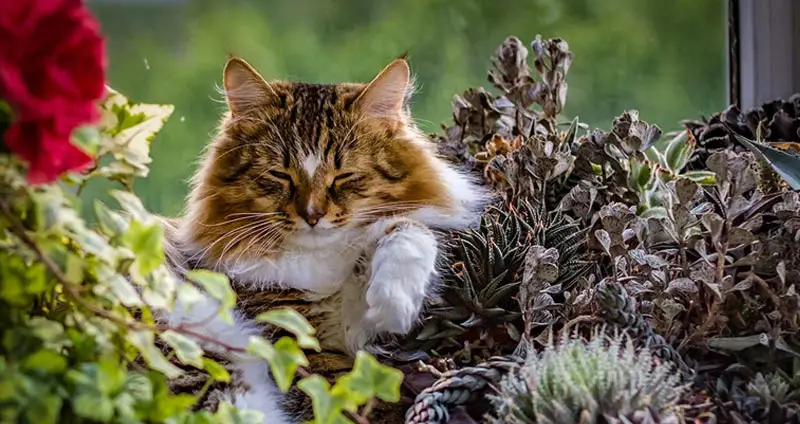In the world of interior decorating, house plants do wonders for transforming a dull space into one that’s relaxing, lively, and great to look at. Among the different types of house plants, succulents reign supreme for their appearance, diversity, and low-maintenance requirements. The popularity of succulents combined with the popularity of pet cats has resulted in households that contain some of both.
Is this overlap between cats and succulents okay? Are succulents poisonous to cats if ingested? What succulents should be avoided at all costs? We’ll answer these questions and more within this post to ensure that your cat remains safe and healthy.
Table of Contents
Are Succulents Poisonous To Cats?
In short, yes, there are some succulents that are poisonous to cats. However, not all succulents are poisonous to cat. With thousands of different types of succulents, there’s bound to be some that are dangerous and others that are completely harmless. Fortunately, most succulents are non-toxic for cats to touch or eat.
If you’re a cat owner that’s looking into bringing a succulent into your home, it’s essential that you look into the succulent that you’re buying. Equally, if you’re bringing a cat into a home filled with succulents, you need to find out what those succulents are before letting your cat out of your sight.
So, what exactly are these succulents that need to be avoided by cats?
Succulents That Are Poisonous To Cats
There aren’t too many succulents that are poisonous to cats, but the few that are can be quite popular within homes. Below we’ve highlighted 7 of the most prominent succulents that are poisonous to cats and shouldn’t be present in homes with cats.
Aloe Vera


Aloe is quite a popular and populous genus that consists of quite a few different species. These succulents have thick and fleshy leaves that are green or bluish-gray-green in color with white flecks. Although aloe vera has quite a common place in modern medicine and remedies, it’s a toxic plant for cats if ingested. The main reason for this is the existence of the chemical saponin in the aloe, which causes serious problems in a cat when ingested.
Symptoms: abdominal pain, lethargy, nausea, skin irritation, vomiting, diarrhea, tremors
Euphorbia (Various)


The Euphorbia family is one of the most commonly known poisonous succulent families. It’s the fourth largest genus of flowering plants and is found in certain regions of Africa and Madagascar. Although there are many different succulents in the Euphorbia family, they should all generally be avoided. These succulents contain a white sap that irritates skin and can cause a rash. When ingested, this sap can irritate the stomach of a cat.
Symptoms: nausea, vomiting, diarrhea, skin irritation
Kalanchoe (Various)


Kalanchoes are extremely popular houseplants due to their diverse beauty and the fact that they’re very easy to care for. Although these succulents aren’t poisonous to humans, it’s known that they’re poisonous to cats and other animals. The harmful chemical in Kalanchoes is bufadienolides cardiac glycosides, and this causes irregular heartbeats. Most times when this plant is eaten, it only results in mild irritation. However, it is dangerous in large amounts.
Symptoms: vomiting, diarrhea, lethargy, weakness, abnormal heart rate (rare)
Jade Plant (Crassula ovata)
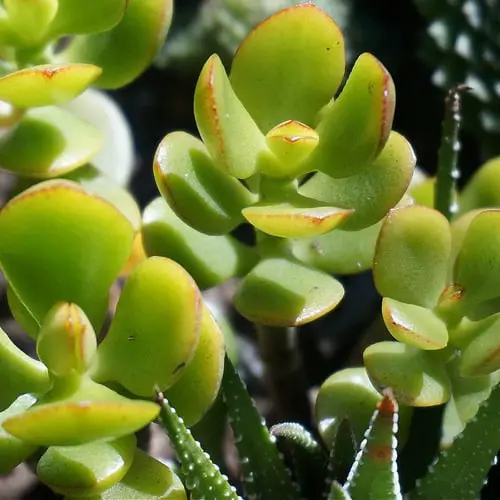

Jade plants are extremely common with over 1400 different kinds in existence. Therefore, it’s quite important that you make sure that none of your succulents are in this family. These difficult-to-kill plants have a rubbery texture and individual little leaves that can be picked off. While the ASPCA isn’t aware of what the toxic chemical in jade is, it is known that jade poisoning can set in quite quickly. Some owners report their cats acting drunk after ingesting jade leaves.
Symptoms: depression, lethargy, incoordination, vomiting
Snake Plant (Sansevieria tariffsciata)
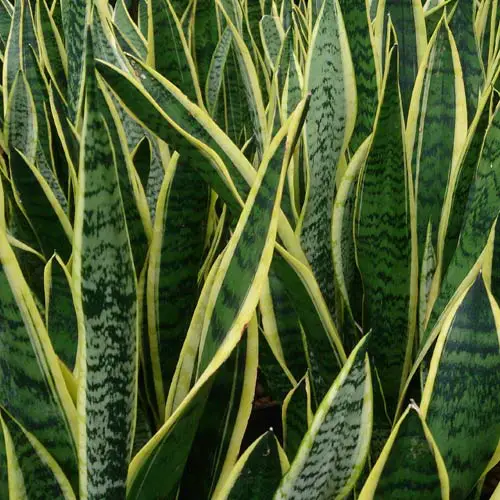

These succulents, also known as Mother-in-Law’s Tongues, have long leaves that wind upwards. Snake plants are popular among beginner succulent keeps as they’re very hardy and can survive throughout a lot of neglect. They also work to purify the air by removing benzene and formaldehyde. Unfortunately, the leaves also contain a chemical called saponin — a chemical that’s found in several other plant species.
Symptoms: nausea, vomiting, diarrhea
String Of Pearls (Senecio rowleyanus)
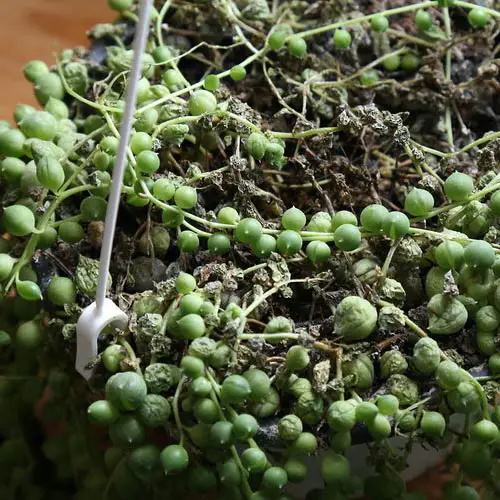

These succulents have recently become very popular due to their unique style and trailing habits. The stems feature round leaves that are very similar to a pea, and they can grow up to 3 feet long. String of pearls also produce fuzzy white flowers that smell quite sweet. This physical appearance makes them quite a target for a lot of house cats. Its sap causes dermatitis and skin irritation in humans and pets, and has worse effects when ingested.
Symptoms: lethargy, skin irritation, drooling, vomiting, diarrhea
Sago Palm (Cycas revoluta)
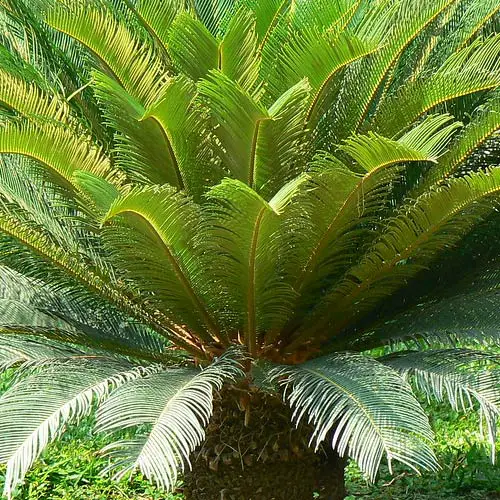

Although the sago palm looks like a basic palm tree, it’s actually considered a succulent. This plant is loved by many succulent owners due to its hardiness and very aesthetic appearance. While it’s a well-loved plant both indoors and out, it’s a very toxic plant all around. While the entire thing is harmful, the easy-to-access seeds are especially dangerous. These palms contain cycasin, which is a chemical that attacks the liver.
Symptoms: thirstiness, liver failure, vomiting
Popular Succulents That Are Safe For Cats
While there are a decent amount of succulents that are off-limits for cats, a majority of them are still entirely safe and non-toxic. If the succulent wasn’t mentioned above, there’s a good chance that it’s not poisonous for cats. However, you’ll still want to verify that each individual succulent that you bring home is entirely safe.
So what succulents are safe for cats? While that list is too long to put here, we will list out some of the most common succulents that are entirely safe for cats to be around or even nibble on (although that shouldn’t be encouraged).
- Aeonium
- Bromeliads
- Christmas Cactus
- Blue Echeveria
- Burro’s Tail
- Ghost Plant
- Hardy Baby Tears
- Haworthia
- Hens and Chickens
- Hoya
- Maroon Chenille Plant
- Mexican Firecracker
- Mexican Rosettes
- Mexican Snowballs
- Painted Lady
- Plush Plant
- Tree Cactus
- Wax Rosette
How To Keep Cats From Eating Succulents
Whether the succulents in your house are poisonous to cats or totally harmless, you obviously don’t want your cat eating your succulents in the first place. Unfortunately this is a bit of a problem as cats are frequently attracted to the chewy green leaves practically beckoning them over. For the sake of the health of your cat and succulents alike, how does one keep their cat from eating these adorable plants?
Make Your Succulents Stink
Since cats have a very acute sense of smell, you can use that characteristic to keep them away from your plants. There are several simple and natural ways that you can make your succulents smell very unappealing. Cats can’t stand the smell of citrus, so adding a lemon peel to the soil of your succulents will do wonders keeping them away. A small sprinkle of cayenne pepper around the plant will also keep a cat quite far away.
Add Cat-Specific Deterrents
If the more natural route of using lemon peels and cayenne pepper doesn’t deter your cat from munching on your succulents, you may have to break out the big guns. Fortunately, there are a few non-toxic sprays that are designed to keep pets away from houseplants. An alternative to this would be a spray bottle filled with 1 part vinegar and 3 parts water.
Choose Succulents That Cats Hate
If your cat is dead-set on eating your succulents, you can go back to square one and only own plants that cats hate. Any plants with thorns such as cactus will mostly go untouched by cats once they experience the thorns themselves. Some aloe vera are also quite spiky, but they should generally be avoided all together due to their toxicity. Of course, you could also go for plants that aren’t succulents but still deter cats such as rosemary.
Place Your Succulents In Good Locations
If you can, placing your plants out of reach of your cat will keep them from getting eaten. If your cat isn’t allowed into a bedroom, bathroom, or office that gets a lot of light, then that might be a good location for your succulents. Height will also keep them out of reach, such as up on a book shelf or in hanging baskets. You’ll have to find a balance between keeping the plant hidden from cats but still visible to you.
What To Do If A Cat Eats A Succulent
In short — don’t panic! If your cat eats a succulent, even if it’s considered a poisonous succulent for cats, it’s almost guaranteed that your cat will be fine.
The side effects that cats will experience after ingesting toxic succulents are simply their bodies’ attempts to purge the succulent from their symptom. If you notice your cat eating your succulent, the best thing that you can do is take the plant away, give your cat some food and water, and monitor them for a couple of hours.
No succulents will kill a cat with just one nibble. Some types, such as Kalanchoe, can potentially be deadly in large amounts, but this is extremely rare. Most cases will simply result in a cat feeling unwell for a little bit, maybe puking or having a loose bowel movement, and then returning to normal in a couple of hours.
However, if you’re concerned about your cat’s health, it’s always recommended that you contact their vet immediately! It’s always better to be safe than sorry when it comes to the health of your furry feline friend. Cats and succulents are both so enjoyable — you wouldn’t want one to be the demise of the other.

